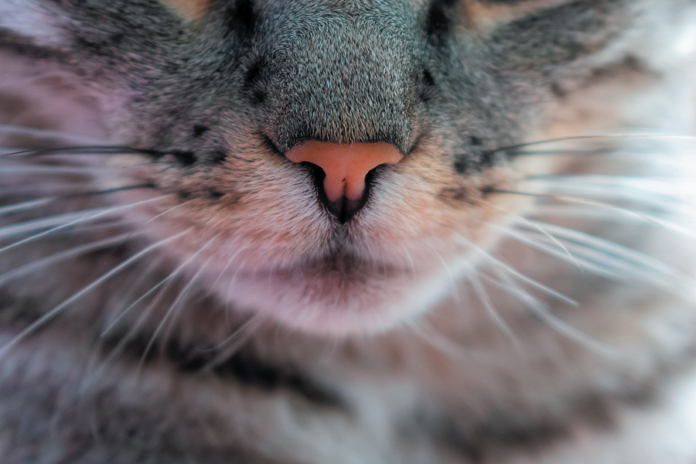Pop quiz!
- True or false? Whiskers are hairs.
- A cat has 6, 10, or 12 whiskers on either side of her nose.
- True or false? The human equivalent of whiskers are the tiny hairs in our ears.
- Whiskers are indeed hairs (they can even turn grey with age). 2. A cat typically has 12 whiskers on either side of her nose (but the number can vary). 3. People do not have an anatomical equivalent to these most extraordinary feline body parts.
Consider the amazing ways in which a cat’s whiskers function.
Whiskers help her “see” in the dark. As a cat walks, she stirs up the air around her. When the air hits a solid object (like a mouse), the air current changes, bouncing back to her, and her whiskers can detect very faint vibrations that indicate the shift. (Another word for a cat’s whiskers is vibrissae, from the Latin for “vibrate.”) The ability of the whiskers to act like antennae in this way are very useful to a cat because felines are far-sighted; their eyes are not terrific at putting into focus prey and other objects right near them. The vibrations of the air currents can tell a cat not only that something is in front of her but also its size, shape, and the speed at which it is moving. All the better for an efficient pounce — or escape from a predator. Blind cats, incidentally, use their vibrissae for orientation.
Whiskers let her know whether she can fit through a narrow space. A cat’s whiskers are roughly as wide as her body, so she is able to judge whether she can fit through a hole or other opening by seeing if her whiskers can make it inside without touching the sides. Note: The whiskers do not get wider if a cat gains weight, so an overweight cat loses the width-gauging ability that whiskers provide.
Whiskers improve proprioception. That’s a fancy way of saying that a cat’s whiskers help her know where her body and limbs are in space. It’s one of the reasons cats tend to look so graceful whether they’re sauntering, pouncing, jumping, or even falling.
Whiskers indicate mood. When a cat’s whiskers are relaxed, so is she. When they’re pushed forward, she is alert and watchful. (You might see this when your cat is chasing a light beam or toy.) And when they’re flattened back on her face, she might be scared — and potentially aggressive.
It’s not surprising that whiskers perform all these functions when you consider that their follicles are embedded three times as deeply into a cat’s skin as her other hair follicles. That allows them access to a large blood supply and a direct connection to bundles of different types of sensitive nerve endings that send all kinds of messages directly to the brain.
A cat has whiskers not only on either side of her nose but also above her eyes, on her chin, and on the backs of her lower front legs. They all help her evaluate her environment and how she is moving around in it. Indeed, about 40 percent of the feline brain’s sensory areas align with parts of the body where a cat has whiskers, and each individual whisker can be traced to a specific brain location.
When shedding whiskers is okay; when it’s not
All cats shed a whisker once in a while, and it’s perfectly normal. Individual whiskers are shed at different times year-round, and another grows in its place, says Tufts veterinary dermatologist Ramón Almela, DVM. But if your cat starts shedding more whiskers than usual, chances are something is amiss, he says. Here are the possibilities.
Infection. An infection from harmful bacteria or a fungus can interfere with the structure of the skin. If the problem is severe enough that whiskers are falling out, an antibiotic or prescription anti-fungal medication may very well be necessary to fight the problem.
Trauma. A cat who lives with other pets or who manages to get out may find herself in a scrape with another animal. That can result in whisker loss. Sometimes, if the “foe” scratches or bites the cat on the face, she may develop an infection from bacteria penetrating the skin. Again, an antibiotic may be in order to eradicate offending bacteria that have colonized.
Acne. The most common place for a cat to develop acne is the chin, but in severe cases the acne can spread toward the lips, causing black heads or pimples that may result in whiskers falling out.
Hair loss disorders. Certain rare skin disorders, such as one called pseudopelade (a kind of alopecia), can cause loss of hair on the face, including loss of the whiskers. Rare congenital diseases can also result in a lack of (or smaller) whiskers. And severe allergies can cause whisker damage — and maybe loss — due in part to incessant scratching or rubbing of the face. The itchiness gets the scratching going. A visit to the veterinarian is necessary to determine the cause of the allergy and also to get a prescription for medication that will help tamp down on symptoms.
Don’t touch!
Barring an allergy or some other problem that could affect the skin around a cat’s whiskers, they will take care of themselves throughout a cat’s life. You should not try to brush or trim these exquisitely sensitive, specialized hairs. Nor should you touch them simply because they’re such an interesting feline feature. That’s too much sensation. Your cat won’t like it, and she won’t appreciate the temporary interference with their function. Better to just let nature do its thing.





Regarding food dish, I would add to avoid plastic and use ceramic. Your kitty may be sensitive to elements in plastic and develop chin acne.